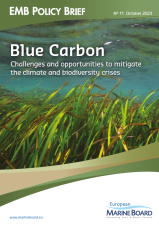
Climate change and biodiversity loss are two of humanity’s greatest challenges. Blue carbon, i.e. the carbon captured and stored by marine living organisms and ecosystems, has the potential to help mitigate both challenges, because marine ecosystems that are important for sequestering carbon often also harbour rich biodiversity. Expanding and protecting Blue Carbon ecosystems has therefore been proposed as a Nature-based Solution to complement climate change mitigation efforts on land and to protect and restore marine biodiversity. In addition, securing and rebuilding Blue Carbon ecosystems can stabilise livelihoods, protect coasts, and support other societal needs such as food provision from the Ocean.
However, the effectiveness of Blue Carbon ecosystems as a Nature-based Solution depends on the available space and ecosystem productivity, which can be impacted by climate change. Moreover, the overall carbon sequestration potential of Blue Carbon ecosystems is low and their contribution to climate stabilisation will only be significant once emissions are strongly limited. Therefore, a drastic reduction of greenhouse gas emissions to keep global warming close to 1.5°C above pre-industrial levels is essential to maintain the health and long-term functionality of Blue Carbon ecosystems as a Nature-based Solution.
This document describes examples and benefits of Blue Carbon ecosystems, and discusses uncertainties and challenges for using Blue Carbon ecosystem as a climate change solution. It also highlights the wider role of the Ocean in mitigating climate change through the carbon cycle, and closes with key research and management recommendations.
You can find out more about the EMB Blue Carbon Working Group here.
The publication was presented during a dedicated webinar. You can re-watch the recording here and download the PowerPoint slides here.